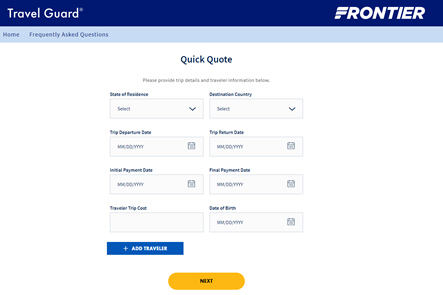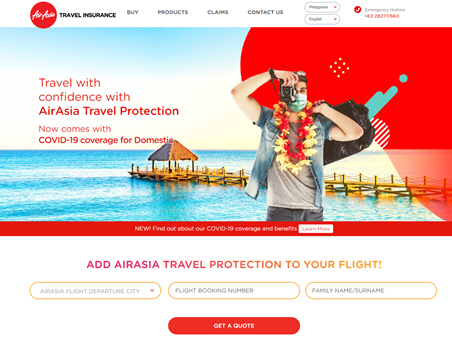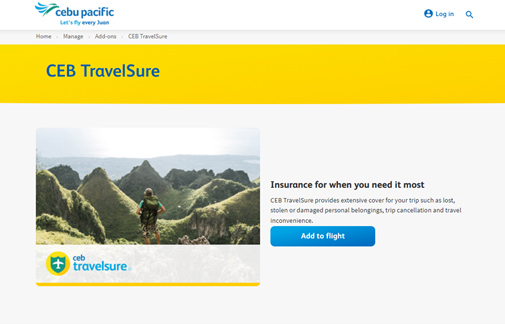
White labeling offers airlines and travel insurers a unique opportunity to enhance their offerings and stay ahead of their game. This practice involves both parties partnering together to provide insurance products that are either branded and sold solely by the airline, or co-branded by both of them and sold through a single platform.
Usually, travel insurance products are offered in-path, allowing customers to instantly add travel insurance while booking. However, this isn’t always the case. Many customers are undecided about opting for travel insurance until the last minute. Here’s how the beauty of white-labeled travel insurance products shines through. Customers can just proceed to a dedicated page where they can add travel insurance into their existing travel package.
In this article, we’ll explore the concept of white labeling in travel insurance, including how it works, and its potential as a win-win strategy for airlines and travel insurers. We’ll also showcase some successful use cases of white labeling partnerships.
White labeling in travel insurance refers to the practice where a travel insurer provides insurance products that are branded and sold by an airline under the airline’s name or logo. These insurance products are either integrated into the airline’s booking process or made available on a dedicated page for customers to purchase.
There are two main types of white label travel insurance: fully airline-branded and co-branded. In fully airline-branded, the insurance product is presented solely under the airline’s brand, with no mention of the travel insurer. This gives the impression that the insurance is directly provided by the airline.
In contrast, co-branded white label insurance includes both the airline’s and the travel insurer’s branding. This approach allows for a more transparent presentation of the insurance product, as customers are aware of the insurer behind the coverage.
White labeling has significant implications for airlines and travel insurers in many aspects.
For Airlines:
Offering white label travel insurance products can enhance their brand image by providing customers with a more comprehensive travel experience. It allows airlines to position themselves as providers of complete travel solutions.
On top of that, in a tough market where airlines often compete on price and schedule, offering white label insurance sets airlines apart by providing added value and a unique selling proposition. This differentiation can help airlines attract and retain customers, ultimately leading to increased revenue and market share
For Travel Insurers:
White labeling presents travel insurance providers with a strategic opportunity to expand their customer base and increase brand visibility. By partnering with airlines, travel insurers can tap into the airline’s existing customer base, which is often vast and diverse. This can result in increased policy sales and brand awareness among travelers who may not have considered purchasing travel insurance otherwise.
Furthermore, white labeling allows travel insurers to leverage the airline’s marketing channels and reduce their own marketing costs. Most airlines have well-established marketing strategies and reach a large audience. Travel insurers can take advantage of this opportunity to maximize their exposure and grow their business in a cost-effective manner.
To sum up, white labeling in travel insurance is a strategic partnership that brings significant advantages to both airlines and travel insurers. In the next section, we’ll explore real-world examples of successful white labeling partnerships, showcasing the practical benefits and outcomes of this approach.

Frontier and Travel Guard’s collaboration exemplifies a successful co-branded white label travel insurance initiative. They developed a dedicated webpage where customers can easily purchase travel insurance as part of their travel plans. The webpage prominently features both Frontier and Travel Guard’s logos, providing customers with a clear indication of the partnership.
The dedicated webpage offers customers a user-friendly interface where they can easily request travel insurance quotations, file claims, check claim statuses, and manage their existing insurance policies. This streamlined process enhances the overall customer experience, making it convenient for travelers to protect their trips.
Through this white label partnership, customers are provided with a sense of security and peace of mind, knowing that they are covered by a reputable insurance provider.

Delta Airlines and Allianz’s collaboration showcases a fully airline-branded white label travel insurance approach. The webpage dedicated to travel insurance prominently features Delta Airlines’ logo, seamlessly integrating the insurance offering into Delta’s brand identity. This branding strategy reinforces Delta’s commitment to customer care and safety, as the airline is perceived as directly providing the insurance coverage.
One of the key strengths of Delta and Allianz’s initiative is the website’s design, which effectively communicates the benefits of the travel insurance offering to customers. The webpage is designed to highlight the value proposition of the insurance product, emphasizing the protection and value it provides to travelers. Customers can easily request quotes tailored to their needs, further enhancing the user experience and driving conversions.
Delta Airlines and Allianz’s fully airline-branded white label travel insurance initiative demonstrates how strategic partnerships can enhance brand perception and customer loyalty while providing valuable insurance coverage to travelers.

AirAsia’s partnership with its in-house travel insurance provider, Tune Protect, showcases another successful fully-airline branded white label partnership. Their website is a standout example of effective design that combines text and graphics to convey their message. The website is designed to be user-friendly, with clear navigation and informative content that highlights the benefits of purchasing travel insurance through AirAsia.
Similar to the previous case studies, AirAsia and Tune Protect’s white label website provides customers with the facilities to purchase travel insurance, as well as submit claims. This streamlined process enhances the overall customer experience, making it easy for travelers to protect themselves and their trips.
AirAsia and Tune Protect’s fully-airline branded white label partnership demonstrates the value of collaboration in delivering a seamless and integrated travel insurance experience for customers.

Cebu Pacific’s partnership with Chubb exemplifies another successful white label partnership in the travel insurance industry. Together, they introduced a new branding for their travel insurance called CEB TravelSure, which is aligned with Cebu Pacific’s branding and color scheme. This branding strategy helps customers easily identify and associate the travel insurance offering with Cebu Pacific, enhancing brand recognition and trust.
CEB TravelSure offers extensive coverage for lost, stolen, or damaged personal belongings, trip cancellation, and travel inconvenience. This comprehensive coverage is designed to provide travelers with peace of mind and financial protection during their trips.
The website developed for CEB TravelSure allows customers to seamlessly add a travel insurance plan to their flight booking. This user-friendly interface simplifies the insurance purchasing process, making it convenient for travelers to protect themselves and their belongings.
Cebu Pacific and Chubb’s white label partnership highlights the importance of collaboration in providing customers with valuable travel insurance options that complement their travel experience.
These successful case studies demonstrate the versatility and adaptability of white labeling in travel insurance. Airlines and travel insurers can choose a branding approach (co-branded or fully airline-branded) that best aligns with their strategic goals and target audience. Regardless of the branding strategy, successful white label partnerships offer a win-win scenario for all parties involved.
Looking ahead, white labeling holds immense potential for growth within the travel insurance market. By fostering collaboration and innovation, airlines and travel insurers can leverage this strategy to provide even more comprehensive and personalized travel insurance solutions, further enhancing the travel experience for customers worldwide.
These insights are an extract of our 2024 Top 50 Airlines Travel Insurance Benchmark report.
Meanwhile, you might be interested in our past years release: